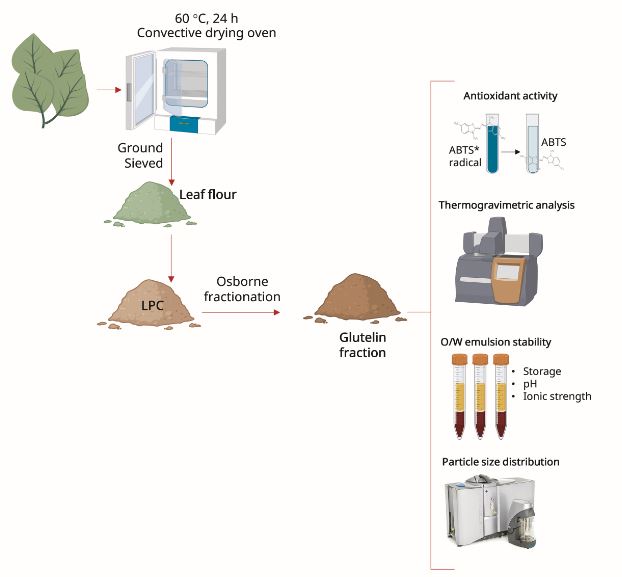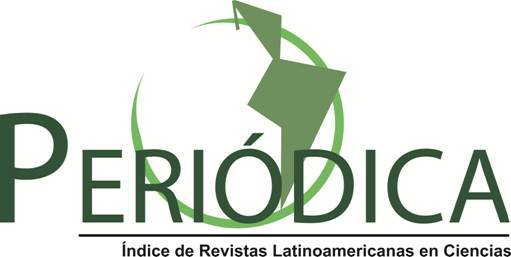Fracción de glutelina del concentrado proteico de hoja de yaca: un nuevo emulsionante para la estabilización de emulsiones de aceite en agua con propiedades antioxidantes y estabilidad térmica
Un nuevo emulsionante para la estabilización de emulsiones
DOI:
https://doi.org/10.18633/biotecnia.v27.2621Palabras clave:
antioxidantes, distribución del tamaño de partículas, fracción proteica, análisis termogravimétricoResumen
La investigación de proteínas vegetales como emulsionantes ha ido en aumento considerablemente. La fracción de glutelina del concentrado proteico de hoja de yaca se muestra prometedora como emulsionante. Este estudio tuvo como objetivo evaluar la actividad de eliminación de radicales (RSA), el perfil térmico mediante análisis termogravimétrico y los parámetros cinéticos y termodinámicos de la fracción de glutelina. Se utilizó ultrasonido para crear emulsiones de aceite en agua (O/W), y se evaluó su estabilidad bajo diferentes condiciones simuladas. La fracción de glutenina exhibió 50% ABTS+ RSA a 0.377 ± 0.004 mg/mL y estabilidad térmica hasta 239.7 °C. Los parámetros cinéticos y termodinámicos indicaron que su descomposición térmica es un proceso endotérmico. La emulsión creada con glutelina al 0.5% (p/v) exhibió un tamaño promedio de gota de 2.4 µm. La emulsión se mantuvo estable durante 5 días tanto a 4 °C como a 25 °C, fue estable en un rango de pH de 6.0 a 8.0, con estabilidad moderada en presencia de NaCl. La glutelina puede ser un emulsionante que posee buena estabilidad térmica y RSA y eficaz para crear emulsiones O/W (en ciertas condiciones). Esta fracción proteica es una alternativa vegetal a los emulsionantes tradicionales.
Descargas
Citas
Aguilar‐Toalá, J.E. and Liceaga, A.M., 2021. Cellular antioxidant effect of bioactive peptides and molecular mechanisms underlying: beyond chemical properties. International Journal of Food Science & Technology, 56 (5), 2193–2204.
Calderón-Chiu, C., Calderón-Santoyo, M., Barros-Castillo, J.C., Díaz, J.A., and Ragazzo-Sánchez, J.A., 2022. Structural Modification of Jackfruit Leaf Protein Concentrate by Enzymatic Hydrolysis and Their Effect on the Emulsifier Properties. Colloids and Interfaces, 6 (4), 52.
Calderón-Chiu, C., Calderón-Santoyo, M., Damasceno-Gomes, S., and Ragazzo-Sánchez, J.A., 2021. Use of jackfruit leaf (Artocarpus heterophyllus L.) protein hydrolysates as a stabilizer of the nanoemulsions loaded with extract-rich in pentacyclic triterpenes obtained from Coccoloba uvifera L. leaf. Food Chemistry: X, 12, 100138.
Calderón-Chiu, C., Calderón-Santoyo, M., Herman-Lara, E., and Ragazzo-Sánchez, J.A., 2021. Jackfruit (Artocarpus heterophyllus Lam) leaf as a new source to obtain protein hydrolysates: Physicochemical characterization, techno-functional properties and antioxidant capacity. Food Hydrocolloids, 112, 106319.
Calderon-Chiu, C., Calderón-Santoyo, M., and Ragazzo-Sánchez, J.A., 2024. Protein Fractions of Jackfruit Leaf Flour and Protein Concentrate: Amino Acid Profile, Functional Properties and Thermal Analysis. Applied Sciences, 14 (20), 9155.
Calderón-Chiu, C., Ragazzo-Sánchez, J.A., Ordaz-Hernández, A., and Herrera-Martínez, M., 2024. Jackfruit Leaf Protein Hydrolysates Obtained by Enzymatic Hydrolysis of Leaf Protein Concentrate with Pepsin and Pancreatin: Molecular Weight, Cytotoxicity, Antiproliferative Activity, and Oxidative Stress. Plant Foods for Human Nutrition, 79 (3), 685–692.
Calderón-Santoyo, M., Calderón-Chiu, C., and Ragazzo-Sánchez, J.A., 2025. Characterisation of Hydrophilic Bioactive Extracts of Fruits from Mexico: Phenolic Content, Thermal and Kinetic and Thermodynamic Analysis. Plant Foods for Human Nutrition, 80 (1), 83.
Calderón‐Santoyo, M., González‐Cruz, E.M., Iñiguez‐Moreno, M., Ramos‐Martínez, O., Burgos‐Hernández, A., and Ragazzo‐Sánchez, J.A., 2022. Microencapsulation of Phenolic Extract from Sea Grape ( Coccoloba uvifera L.) with Antimutagenic Activity. Chemistry & Biodiversity, 19 (11).
Chen, W.-H., Chu, Y.-S., Liu, J.-L., and Chang, J.-S., 2018. Thermal degradation of carbohydrates, proteins and lipids in microalgae analyzed by evolutionary computation. Energy Conversion and Management, 160, 209–219.
Fasolin, L.H., Pereira, R.N., Pinheiro, A.C., Martins, J.T., Andrade, C.C.P., Ramos, O.L., and Vicente, A.A., 2019. Emergent food proteins – Towards sustainability, health and innovation. Food Research International, 125, 108586.
Gao, K., Rao, J., and Chen, B., 2024. Plant protein solubility: A challenge or insurmountable obstacle. Advances in Colloid and Interface Science, 324, 103074.
van Gils, J.H.M., Mouhib, H., van Dijk, E., Dijkstra, M., Houtkamp, I., Goetzee, A., Abeln, S., and Feenstra, A.K., 2023. Thermodynamics of Protein Folding. In: J.H.M. van Gils, A.K. Feenstra, and S. Abeln, eds. Introduction to Protein Structural Bioinformatics. 1–22.
Gomes, A. and Sobral, P.J.D.A., 2021. Plant Protein-Based Delivery Systems: An Emerging Approach for Increasing the Efficacy of Lipophilic Bioactive Compounds. Molecules, 27 (1), 60.
Gonçalves, R.F.S., Martins, J.T., Duarte, C.M.M., Vicente, A.A., and Pinheiro, A.C., 2018. Advances in nutraceutical delivery systems: From formulation design for bioavailability enhancement to efficacy and safety evaluation. Trends in Food Science & Technology, 78, 270–291.
Kaur, G. and Bhatia, S., 2022. Radish leaf protein concentrates: optimization of alkaline extraction for production and characterization of an alternative plant protein concentrate. Journal of Food Measurement and Characterization, 16 (4), 3166–3181.
Lam, R.S.H. and Nickerson, M.T., 2013. Food proteins: A review on their emulsifying properties using a structure–function approach. Food Chemistry, 141 (2), 975–984.
Li, Y., Wang, Y., Chai, M., Li, C., Nishu, Yellezuome, D., and Liu, R., 2023. Pyrolysis kinetics and thermodynamic parameters of bamboo residues and its three main components using thermogravimetric analysis. Biomass and Bioenergy, 170, 106705.
Ling, Z., Ai, M., Zhou, Q., Guo, S., Zhou, L., Fan, H., Cao, Y., and Jiang, A., 2020. Fabrication egg white gel hydrolysates-stabilized oil-in-water emulsion and characterization of its stability and digestibility. Food Hydrocolloids, 102, 105621.
Marouani, M. El, Bouzbib, M., Hamdaoui, L. El, Pienaar, A., Trif, L., Tagne, M.S., and Kifani-Sahban, F., 2020. Eriobotrya japonica Lindl. Kernels: Kinetics of Thermal Degradation under Inert Atmosphere Using Model-Free and Fitting Methods. Biointerface Research in Applied Chemistry, 11 (4), 11357–11379.
Münch, K., Schroën, K., and Berton‐Carabin, C., 2024. Relevance of various components present in plant protein ingredients for lipid oxidation in emulsions. Journal of the American Oil Chemists’ Society, 101 (10), 1065–1084.
Nascimento, R.G., Porfírio, M.C.P., Nascimento, P.A., Alves, A.N., Santos, L.S., Veloso, C.M., Bonomo, R.C.F., and Fontan, R. da C.I., 2022. A novel hydrophobic matrix grafted with aniline for protein capture and thermodynamic study of BSA adsorption. Journal of Polymers and the Environment, 30 (8), 3230–3238.
Nynäs, A.-L., Newson, W.R., Langton, M., Wouters, A.G.B., and Johansson, E., 2023. Applicability of leaf protein concentrates from various sources in food: Solubility at food-relevant pH values and air-water interfacial properties. LWT, 184, 114962.
Ozturk, B., Argin, S., Ozilgen, M., and McClements, D.J., 2015. Formation and stabilization of nanoemulsion-based vitamin E delivery systems using natural biopolymers: Whey protein isolate and gum arabic. Food Chemistry, 188, 256–263.
Pan, F.G., Yang, E.Q., Xu, J.Y., Lu, Y.F., Yang, C.X., Zhang, Y.D., Li, S., and Liu, B.Q., 2022. Review on preparation methods, mechanisms and applications for antioxidant peptides in oil. Grasas y Aceites, 73 (4), e478.
Parthasarathy, P., Fernandez, A., Singh, D.K., Al-Ansari, T., Mackey, H.R., Rodriguez, R., Mazza, G., Tirkey, J.V., and McKay, G., 2022. Thermogravimetric analysis of camel dung, date stone, and their blend for pyrolytic, kinetic, and thermodynamic studies. Cleaner Chemical Engineering, 4, 100072.
Phiri, R., Rangappa, S.M., and Siengchin, S., 2024. Agro-waste for renewable and sustainable green production: A review. Journal of Cleaner Production, 434, 139989.
Qoms, M.S., Arulrajah, B., Shamsudin, R., Ibadullah, W.Z.W., and Saari, N., 2022. Valorization of green biomass Azolla pinnata fern: multi‐parameter evaluation of processing conditions on protein extractability and their influence on the physicochemical, structural, techno‐functional properties and protein quality. Journal of the Science of Food and Agriculture, 102 (15), 6974–6983.
Re, R., Pellegrini, N., Proteggente, A., Pannala, A., Yang, M., and Rice-Evans, C., 1999. Antioxidant activity applying an improved ABTS radical cation decolorization assay. Free Radical Biology and Medicine, 29 (9–10), 1231–1237.
Samborska, K., Boostani, S., Geranpour, M., Hosseini, H., Dima, C., Khoshnoudi-Nia, S., Rostamabadi, H., Falsafi, S.R., Shaddel, R., Akbari-Alavijeh, S., and Jafari, S.M., 2021. Green biopolymers from by-products as wall materials for spray drying microencapsulation of phytochemicals. Trends in Food Science & Technology, 108, 297–325.
Xu, N., Chen, G., and Liu, H., 2017. Antioxidative Categorization of Twenty Amino Acids Based on Experimental Evaluation. Molecules, 22 (12), 2066.
Yiga, V.A., Katamba, M., Lubwama, M., Adolfsson, K.H., Hakkarainen, M., and Kamalha, E., 2023. Combustion, kinetics and thermodynamic characteristics of rice husks and rice husk-biocomposites using thermogravimetric analysis. Journal of Thermal Analysis and Calorimetry, 148 (21), 11435–11454.
Zang, X., Yue, C., Wang, Y., Shao, M., and Yu, G., 2019. Effect of limited enzymatic hydrolysis on the structure and emulsifying properties of rice bran protein. Journal of Cereal Science, 85, 168–174.

Publicado
Cómo citar
Número
Sección
Licencia
Derechos de autor 2025

Esta obra está bajo una licencia internacional Creative Commons Atribución-NoComercial-CompartirIgual 4.0.
La revista Biotecnia se encuentra bajo la licencia Atribución-NoComercial-CompartirIgual 4.0 Internacional (CC BY-NC-SA 4.0)















_(2).jpg)








